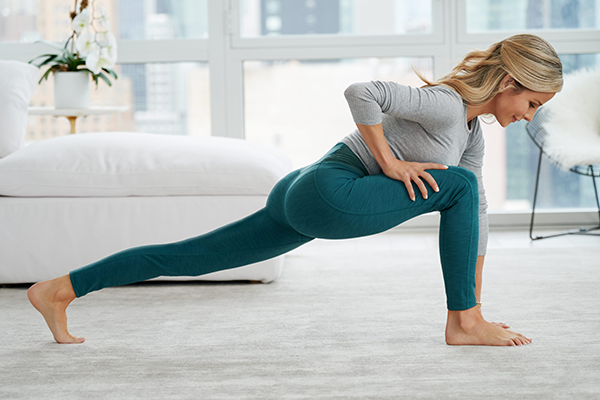
[ad_1]
The runner’s lunge is a staple stretch for runners and sun-saluting yogis, however the transfer may very well be most useful to those that spend extra time on the sofa than the observe or yoga mat.
Amongst a number of different points, extreme sitting causes tightness within the decrease physique. The runner’s lunge, when achieved correctly, can assist fight that.
However, so as to obtain actual outcomes (and reduction), it’s essential to carry out the runner’s lunge correctly.
Runner’s Lunge: Step-by-Step Directions
- Stand together with your ft about hip-width aside. With knees barely bent, bend ahead at your waist and place your palms subsequent to the outer edges of your ft.
- Bend your proper knee and prolong your left foot behind you, putting the ball of your left foot on the bottom. For added stability, gently decrease your left knee to the bottom. You possibly can place a towel or mat below your knee for consolation if wanted.
- In accordance with your degree of flexibility and luxury, decrease your hips, permitting your physique to sink into the stretch. You must really feel the stretch in your hip flexors, quadriceps, and calves.
- Maintain the runner’s lunge for as much as 30 seconds earlier than switching legs.
Runner’s Lunge Advantages and Muscle groups Labored
The runner’s lunge stretches your calves and quadriceps, however you’ll really feel the most important launch in your hip flexors, the muscle mass that provide help to draw your knees towards your chest.
In case you spend most of your waking hours together with your hips flexed (e.g., commuting by automobile or sitting at a desk), you in all probability have tight hip flexors and may profit from the runner’s lunge.
“Tight hip flexors generally is a results of poor posture, muscle imbalance, or sitting an excessive amount of,” says Melissa Morris, MS, ACSM-certified train physiologist. “Tight hip flexors could cause poor working type and a number of lower-body points, like low again ache, knee ache, or ankle and foot points. The runner’s lunge stretches the hip flexors and prevents them from being overly tight.”
Suggestions for the Runner’s Lunge
1. Heat up first
Morris recommends doing the runner’s lunge solely after you’ve warmed up or labored out.
“You by no means wish to do static stretching (the place you maintain a stretch) when your muscle mass haven’t been warmed up previous to the stretch. There isn’t a profit, and it might even have an effect on efficiency,” she explains.
2. Deal with type
Correct type can be essential when performing the runner’s lunge, for each efficacy and harm prevention. To guard the knee of the entrance leg of the runner’s lunge, ensure that it doesn’t prolong past the toes.
3. Loosen up your hips
Watch out about holding stress in your hips whereas doing the runner’s lunge, says Caleb Backe, CPT.
“Many individuals make the error of holding their hips tight so as to keep stability,” he says. “Let your hips sink to expertise the stretch as deep as potential.” In case you wrestle to take care of stability, decrease your again knee to the ground.
4. It’s not a contest
Relating to holding the runner’s lunge stretch, longer isn’t all the time higher.
“Chances are you’ll carry out the runner’s lunge throughout a yoga class for a protracted time period, however the secret’s to take care of the right posture and modifications for at the least 30 seconds,” says Marqui Rennalls, DPT, pelvic ground bodily remedy specialist. “Holding it for longer is just useful for those who can keep the right posture all through that point.”
[ad_2]
